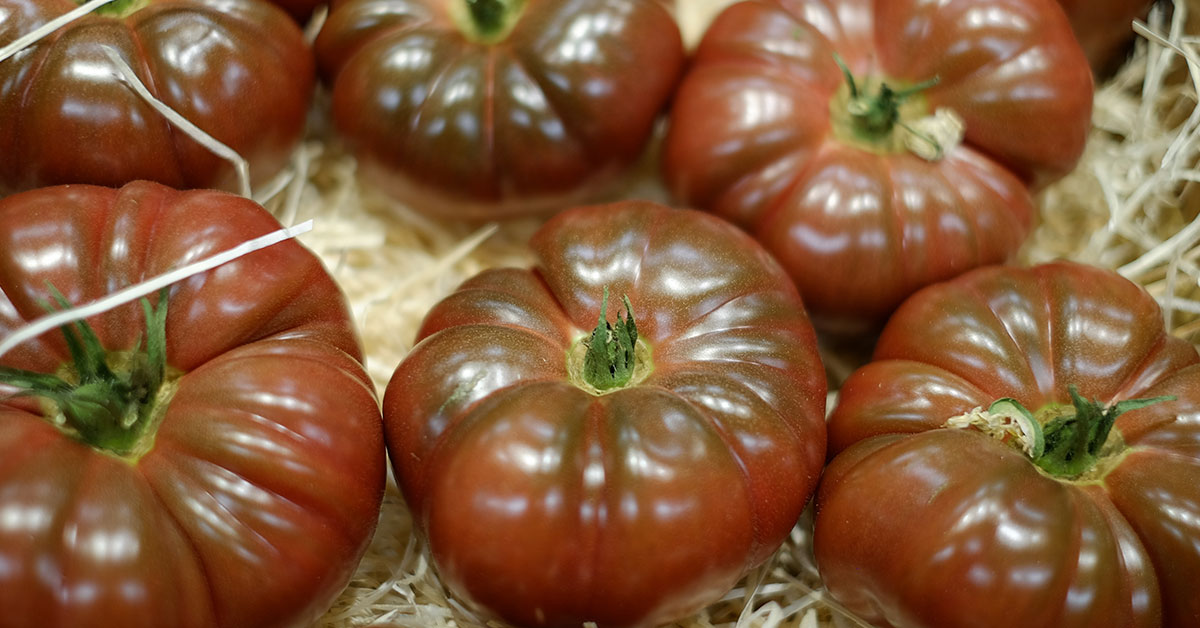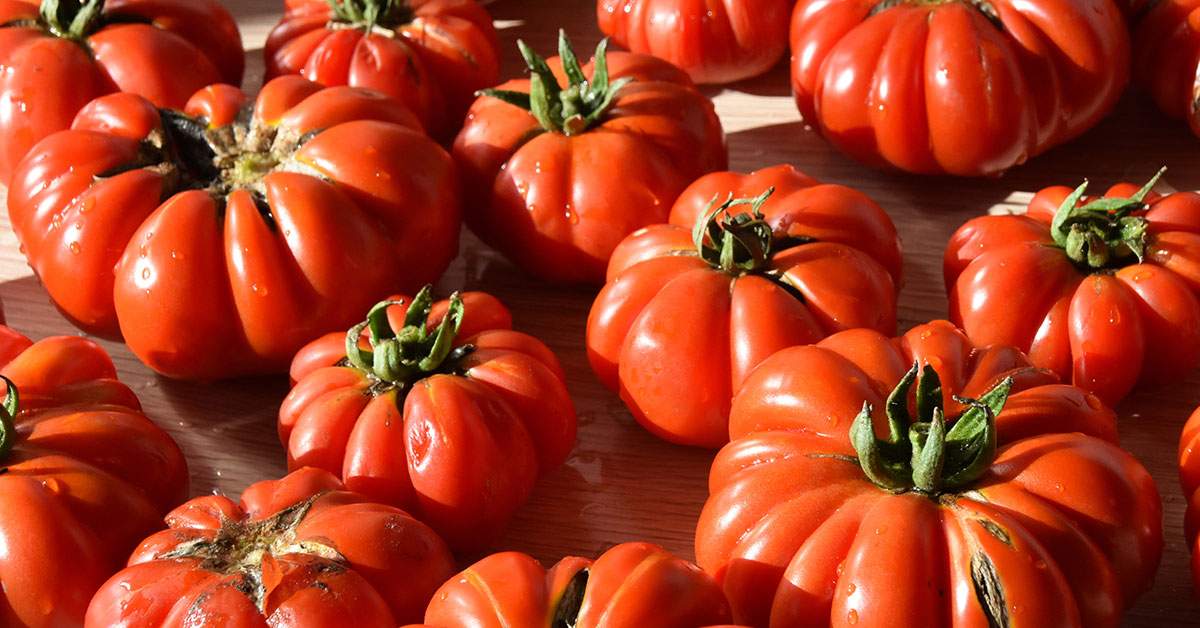The Cherokee Purple tomato is a unique variety of tomato that has been gaining popularity in recent years. This tomato has a rich history and a distinct flavor that sets it apart from other tomatoes.
With its deep purple color and meaty texture, the Cherokee Purple tomato is a favorite among gardeners and food enthusiasts alike. In this blog post, we’ll take a closer look at the Cherokee Purple tomato and explore why it’s become such a beloved variety.
What is a Cherokee Purple tomato?
This variety of tomato is known for its unique color, which is a deep, rich purple with greenish shoulders. The Cherokee Purple tomato is often described as having a complex, sweet flavor with a slightly smoky undertone. It is a popular choice among gardeners and food enthusiasts alike, and is often used in salads, sandwiches, and other dishes.
The Cherokee Purple tomato is also known for its large size, with some fruits weighing up to 1 pound each. The plant itself is indeterminate, meaning that it will continue to grow and produce fruit throughout the growing season. This can make it a good choice for gardeners who want a steady supply of fresh tomatoes throughout the summer months.
Overall, the Cherokee Purple tomato is a unique and flavorful variety that is well worth trying if you are a fan of tomatoes. Whether you are a seasoned gardener or simply looking for something new to try in your kitchen, this heirloom tomato is sure to make a delicious addition to your meals.
Common problems
Cherokee Purple tomatoes are a popular heirloom variety that many gardeners love to grow. They are known for their rich flavor and beautiful, deep purple color. However, like all plants, Cherokee Purple tomatoes are susceptible to certain problems. Here are some common issues that gardeners may encounter when growing Cherokee Purple tomatoes:
- Blossom End Rot – This is a common problem with many tomato varieties, including Cherokee Purple. Blossom end rot occurs when the bottom of the tomato turns black and becomes sunken. This is caused by a calcium deficiency in the plant. To prevent this issue, make sure the soil is well-draining and add calcium-rich amendments like eggshells or bone meal to the soil.
- Cracking – Cherokee Purple tomatoes are prone to cracking, especially if they are left on the vine too long or if there is a sudden change in temperature. To prevent cracking, harvest the tomatoes when they are fully ripe and avoid exposing them to sudden temperature changes.
- Fusarium Wilt – This is a soil-borne disease that can affect Cherokee Purple tomatoes. It causes the leaves to wilt and turn yellow, and can eventually kill the plant. To prevent fusarium wilt, make sure to rotate your crops and avoid planting tomatoes in the same spot year after year.
- Tomato Hornworms – These pests can be a major problem for Cherokee Purple tomatoes. They are large green caterpillars that can quickly strip a plant of its leaves and fruit. To control tomato hornworms, handpick them off the plant and destroy them, or use an organic insecticide.
By being aware of these common problems, gardeners can take steps to prevent them and ensure a successful harvest of delicious Cherokee Purple tomatoes.
How to start Cherokee Purple tomatoes from seed
Starting tomatoes from seed is a cost-effective and rewarding way to grow your own tomato plants. To begin, choose the tomato varieties that suit your preferences and growing conditions.
Fill seed trays or pots with a lightweight and well-draining seed starting mix, plant the seeds at the recommended depth, and provide adequate moisture and warmth for germination.
Once the seedlings have developed their second set of true leaves, they can be transplanted into larger containers or individual pots. Gradually acclimate the seedlings to outdoor conditions before transplanting them into the garden.
By following these basic steps, you can successfully start tomatoes from seed and enjoy a thriving crop of homegrown tomatoes.
Additional Resource: Our comprehensive guide to starting tomatoes from seed
Growing & care
Transplanting and caring for tomatoes outdoors involves a few essential steps. First, choose a sunny location with well-drained soil. Prior to transplanting, harden off the seedlings by gradually exposing them to outdoor conditions.
Dig a hole slightly larger than the root ball of each seedling and plant them, burying the stem up to the first set of leaves. Water the seedlings thoroughly after transplanting. Provide consistent watering, aiming for 1-2 inches of water per week.
Stake or cage the plants for support and prune indeterminate varieties by removing suckers. Monitor for pests and diseases, taking prompt action if necessary. By following these steps, you’ll set your tomato plants up for healthy growth and a fruitful harvest.
Additional Resource: How to transplant and care for tomatoes outdoors
Common tomato pests and diseases
Tomatoes are susceptible to various pests and diseases that can affect their health and productivity. Some common tomato pests include aphids, tomato hornworms, whiteflies, and cutworms. These pests can cause damage to leaves, stems, and fruit, leading to reduced plant vigor and yield.
Additionally, tomato plants can be affected by diseases such as early blight, late blight, fusarium wilt, and verticillium wilt. These diseases can cause leaf discoloration, wilting, and fruit rot. Proper identification and timely intervention are crucial to effectively manage these pests and diseases and ensure the successful growth of tomato plants.
Additional Resource: Comprehensive list of tomato diseases and pests and how to fix them
Uses
Cherokee Purple tomatoes are a popular variety of heirloom tomatoes that are known for their rich, complex flavor and unique appearance. These tomatoes are typically used in a variety of culinary applications due to their distinct taste and texture.
One of the most common uses of Cherokee Purple tomatoes is in salads. Their meaty texture and sweet, tangy flavor make them an excellent addition to any salad, whether it’s a simple green salad or a more complex pasta or grain salad. Cherokee Purple tomatoes are also great for adding depth of flavor to soups, stews, and sauces.
Another popular use for Cherokee Purple tomatoes is in sandwiches and burgers. Their large size and robust flavor make them a great alternative to traditional tomato slices. They pair particularly well with savory meats like bacon or grilled chicken.
Finally, Cherokee Purple tomatoes are often used in canning and preserving. Their unique flavor and texture make them an excellent choice for making homemade salsa, tomato sauce, and other tomato-based condiments.
Overall, Cherokee Purple tomatoes are a versatile and flavorful ingredient that can be used in a wide variety of culinary applications. Whether you’re a professional chef or a home cook, these tomatoes are sure to add depth and complexity to your recipes.













